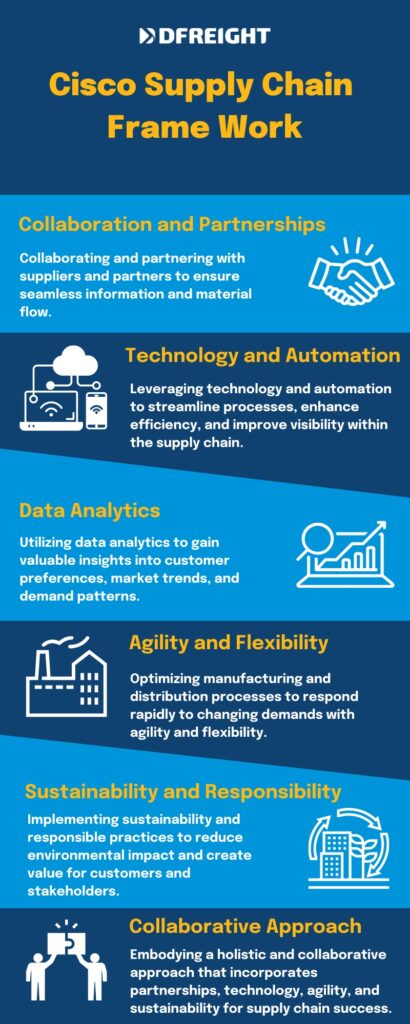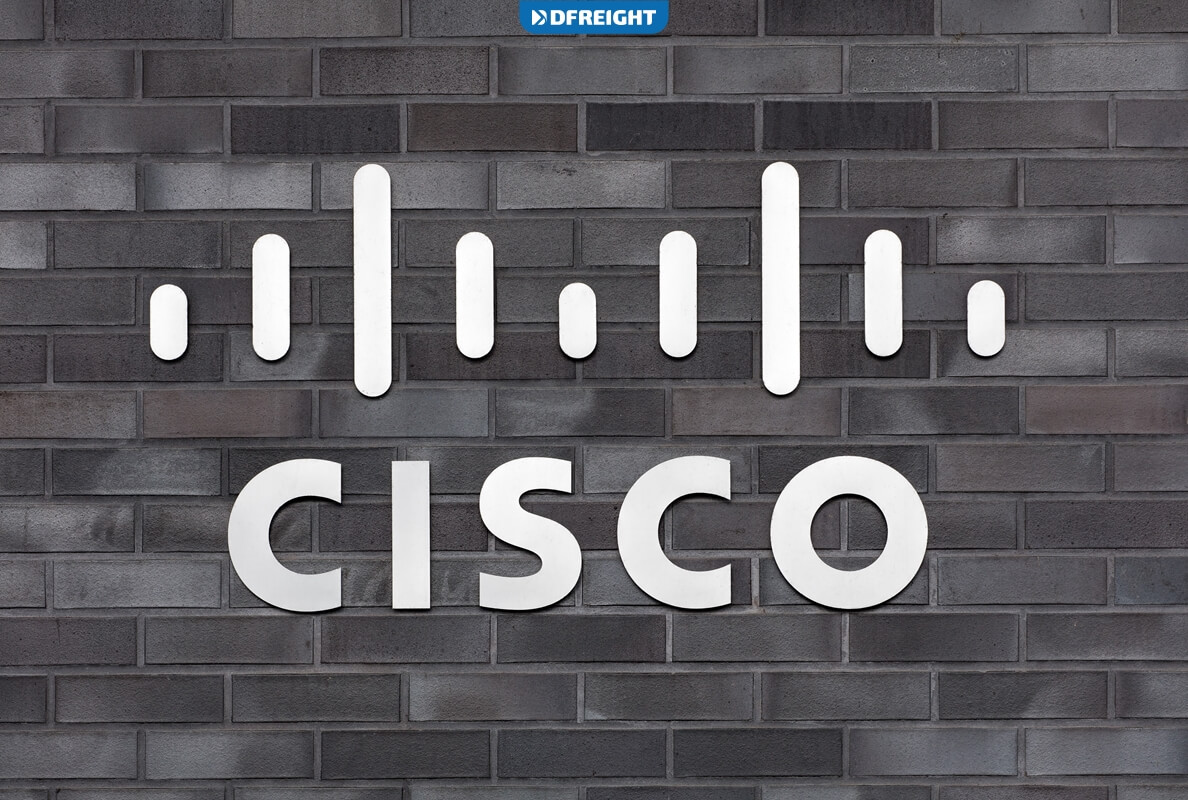In the fast-paced world of technology, where innovation and efficiency are paramount, Cisco Systems has emerged as a global leader in networking solutions. Behind their success lies a well-kept secret: a highly effective supply chain strategy. Imagine a digital freight forwarder with an online platform and mobile app that streamlines your logistics processes, enhances visibility, and boosts efficiency. That’s where DFreight comes in. If you’re looking to manage complex supply chain networks, It’s time to revolutionize your supply chain and optimize your business performance.
In this blog post, we will delve into the inner workings of Cisco supply chain strategy and uncover the key elements that have propelled them to the forefront of the industry.
Table of Contents
Cisco’s Supply Chain Framework
At the core of Cisco’s remarkable supply chain success lies a robust framework that forms the foundation of its operations.

This framework comprises key components that enable Cisco to manage its supply chain and meet customer demands effectively. Central to their approach is the emphasis on collaboration and partnerships with suppliers and partners. By fostering strong relationships and aligning goals, Cisco ensures a seamless flow of information and materials throughout the supply chain.
Technology and automation play a pivotal role in Cisco’s supply chain framework. They leverage advanced technologies to streamline processes, enhance efficiency, and improve visibility. Automation enables Cisco to optimize its operations, reducing manual intervention and errors. By harnessing the power of data analytics, Cisco gains valuable insights into customer preferences, market trends, and demand patterns, enabling them to make informed decisions and anticipate future requirements.
Furthermore, Cisco’s supply chain framework emphasizes the importance of agility and flexibility. They understand the need to adapt quickly to changing market dynamics and customer demands. By embracing lean and agile principles, Cisco optimizes its manufacturing and distribution processes, minimizing waste and responding rapidly to fluctuations in demand.
Another critical aspect of Cisco’s supply chain framework is its commitment to sustainability and responsible practices. They strive to reduce their environmental impact by implementing green initiatives, optimizing energy consumption, and promoting the circular economy. By integrating sustainability into its supply chain, Cisco minimizes its carbon footprint and creates value for its customers and stakeholders.
Overall, Cisco’s supply chain framework embodies a holistic and collaborative approach. They have built a solid foundation that drives their supply chain excellence by focusing on partnerships, technology adoption, agility, and sustainability. This framework serves as a blueprint for other organizations seeking to enhance their supply chain strategies and achieve long-term success in the dynamic global marketplace.
Demand Planning and Forecasting
Cisco Systems excels in demand planning and forecasting, enabling them to align the Cisco supply chain with customer requirements proactively. Cisco accurately identifies demand patterns and market trends through data analytics and advanced forecasting techniques. Collaborating with customers, suppliers, and partners enhances the accuracy of their forecasts. Continuous improvement and predictive analytics further refine their demand planning, allowing them to anticipate shifts in demand and adjust the Cisco supply chain accordingly. By mastering the art of anticipating customer needs, Cisco optimizes its supply chain, enhances customer satisfaction, and maintains its industry leadership.
Efficient Procurement and Supplier Management
Cisco has achieved sourcing success through its commitment to efficient procurement and supplier management practices. Cisco’s procurement process focuses on selecting suppliers based on strict criteria, ensuring alignment with their quality standards and business objectives. Cisco fosters collaboration, innovation, and long-term partnerships by establishing strong relationships with suppliers. Supplier relationship management is critical to their strategy, allowing for effective communication, risk mitigation, and continuous improvement. Cisco’s proactive approach to procurement and supplier management ensures a reliable and streamlined supply chain, contributing to its overall success in the market.
Streamlined Manufacturing and Logistics From Factory to Customer
Cisco excels in streamlining its manufacturing and logistics processes, ensuring a seamless journey from the factory to the customer. By embracing lean and agile principles, Cisco optimizes its manufacturing operations to eliminate waste, improve efficiency, and respond quickly to customer demands. Advanced automation and technology adoption enhance production accuracy and speed while minimizing errors. In logistics, Cisco leverages optimized distribution channels, efficient transportation networks, and real-time visibility to ensure the timely delivery of products to customers worldwide. By focusing on streamlining its manufacturing and logistics, Cisco provides a smooth and reliable supply chain that meets customer expectations and drives its continued success in the market.
The Role of Technology in Cisco Supply Chain Strategy
Cisco demonstrates a strong commitment to digital transformation, leveraging technology as a critical enabler of Cisco’s supply chain success. They harness the power of cutting-edge technologies to enhance visibility, optimize operations, and drive efficiency. Through the Internet of Things (IoT), they gain real-time insights into Cisco’s supply chain, enabling proactive decision-making and rapid response to changes.
Artificial intelligence and machine learning applications help analyze vast amounts of data, unlocking valuable patterns and trends to improve forecasting accuracy. Cisco also embraces blockchain technology to enhance traceability and transparency across the Cisco supply chain. By embracing digital transformation, Cisco ensures a robust and future-ready supply chain that can adapt to the industry’s and customers’ evolving needs.
Sustainability and Green Initiatives
Cisco is committed to sustainability and actively promotes green initiatives throughout its supply chain. Recognizing the importance of minimizing its environmental impact, Cisco sets ambitious goals for reducing carbon emissions, optimizing energy consumption, and promoting sustainable practices. They prioritize responsible sourcing, aiming to work with suppliers who adhere to ethical and sustainable standards. Cisco also embraces the circular economy, implementing recycling and waste reduction strategies. By integrating sustainability into its supply chain operations, Cisco reduces its ecological footprint and creates value for its customers and stakeholders. Their dedication to sustainability sets a positive example for the industry and reinforces their commitment to environmental stewardship.
The Future of Cisco’s Supply Chain
As an industry leader, Cisco continues to pave the way for the future of supply chain management. The company is poised to leverage emerging technologies and trends to stay ahead in an ever-evolving landscape. Predictive analytics and demand sensing will enable Cisco to accurately anticipate customer needs, ensuring proactive and efficient supply chain operations. Robotics and automation advancements will enhance productivity, reducing manual intervention and streamlining processes. Supply chain digitization and connectivity will drive real-time collaboration and data exchange, enabling end-to-end visibility and seamless integration. Cisco’s supply chain future is characterized by innovation, agility, and a commitment to continuously leveraging technology to optimize its operations and exceed customer expectations.
In the previous blogs, we looked into the supply chains of famous and leading companies, which you can read about each of them in the section below.
| Nike | Coca-Cola |
| Apple | Toyota |
| Intel | Starbucks |
| Amazon | Tesla |
| Adidas | Nestle |
| Samsung | Unilever |
| ADNOC | Schneider Electric |
| Pepsi | McDonald |
| McDonald | Zara |
| Walmart | Costco |
| Honda | H&M |
| BMW | KFC |
| L’Oréal |
Conclusion
In conclusion, exploring Cisco’s supply chain strategy provides valuable insights into the key elements that have propelled them to the forefront of the industry. Their emphasis on collaboration, technology adoption, sustainability, and continuous improvement is a blueprint for success in managing a robust and efficient supply chain. By understanding the importance of demand planning, efficient procurement, streamlined manufacturing, embracing digital transformation, and prioritizing sustainability, businesses can learn valuable lessons from Cisco’s approach to supply chain management.
Don’t miss out on the opportunity to optimize your supply chain strategy with DFreight.
What is Cisco’s supply chain strategy?
Cisco’s supply chain strategy focuses on collaboration, technology adoption, sustainability, and continuous improvement. They prioritize efficient procurement, streamlined manufacturing, and optimized logistics to meet customer demands effectively.
How does Cisco anticipate customer needs?
Cisco employs demand planning and forecasting techniques, leveraging data analytics and market insights to anticipate customer needs accurately. By analyzing historical data, trends, and collaborating with customers, they align their supply chain to meet future requirements proactively.
What role does technology play in Cisco’s supply chain?
Technology plays a crucial role in Cisco’s supply chain, enabling enhanced visibility, automation, and efficiency. They utilize IoT for real-time insights, artificial intelligence for data analysis, and blockchain for traceability. Technology empowers Cisco to optimize operations and make informed decisions.
How can businesses manage their supply chain strategy with DFreight?
Businesses can manage their supply chain strategy effectively by utilizing DFreight’s digital freight forwarding services, which offer streamlined logistics operations through their online platform and mobile app.














